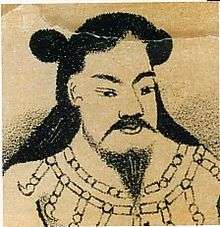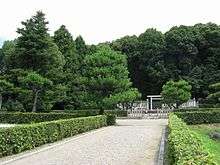Emperor Itoku
Emperor Itoku (懿徳天皇, Itoku-tennō), also known as Ōyamatohikosukitomo no Mikoto (大倭日子鉏友命) was the fourth Emperor of Japan, according to the traditional order of succession.[3][4] Very little is known about this Emperor due to a lack of material available for further verification and study. Itoku is known as a "legendary emperor" among historians as his actual existence is disputed. Nothing exists in the Kojiki other than his name and genealogy. Itoku's reign allegedly began in 510 BC, he had one wife and two sons. After his death in 477 BC, his first son supposedly became the next emperor.
| Itoku | |
|---|---|
 | |
| Emperor of Japan | |
| Reign | 510 BC – 477 BC (traditional)[1] |
| Predecessor | Annei |
| Successor | Kōshō |
| Born | 553 BC[2] |
| Died | 477 BC (aged 76) |
| Burial | Unebi-yama no minami no Manago no tani no e no misasagi (畝傍山南纖沙溪上陵) (Kashihara) |
| Spouse | Amonotoyototsu-hime |
| Issue | |
| House | Imperial House of Japan |
| Father | Emperor Annei |
| Mother | Nunasoko-Nakatsu-hime |
| Religion | Shinto |
Legendary narrative
In the Kojiki and Nihon Shoki, only Itoku's name and genealogy were recorded. While the Japanese have traditionally accepted this sovereign's historical existence, no extant contemporary records have been discovered that confirm a view that this historical figure actually reigned. Itoku is believed to be the son of Emperor Annei, and his mother is believed to have been Nunasoko-Nakatsu-hime. The latter of the two is allegedly the granddaughter of Kotoshiro-Nushi-no-kami.[5] The Kojiki records that Itoku was the second or third son of Emperor Annei, but the surviving documents provide no basis for speculating why the elder brother or brothers were passed over for the throne.[4][5] He is traditionally believed to have ruled from the palace of Migario-no-miya (軽之境岡宮, and in the Nihon Shoki as 軽曲峡宮) at Karu in what would come to be known as Yamato Province.[4] At some point he married a woman named Amonotoyototsu-hime, and fathered two sons with her. Itoku's reign lasted from 510 BC until his death in 477 BC, his son then took the throne and would later be referred to as Emperor Kōshō.[6]
Known information

The existence of at least the first nine Emperors is disputed due to insufficient material available for further verification and study.[7] Itoku is thus regarded by historians as a "legendary Emperor", and is considered to have been the third of eight Emperors without specific legends associated with them.[lower-alpha 1] The name Itoku-tennō was assigned to him posthumously by later generations, and literally means "benign virtue".[9] His name might have been regularized centuries after the lifetime ascribed to Itoku, possibly during the time in which legends about the origins of the Yamato dynasty were compiled as the chronicles known today as the Kojiki.[8] While the actual site of Itoku's grave is not known, the Emperor is traditionally venerated at a memorial Shinto shrine (misasagi) in Kashihara. The Imperial Household Agency designates this location as Itoku's mausoleum. It is formally named Unebi-yama no hitsujisaru Mihodo no i no e no misasagi.[6] The first emperor that historians state might have actually existed is Emperor Sujin, the 10th emperor of Japan.[10] Outside of the Kojiki, the reign of Emperor Kinmei[lower-alpha 2] (c. 509 – 571 AD) is the first for which contemporary historiography is able to assign verifiable dates.[13] The conventionally accepted names and dates of the early Emperors were not confirmed as "traditional" though, until the reign of Emperor Kanmu[lower-alpha 3] between 737 and 806 AD.[8]
Consort and children
Empress: Amonotoyototsu-hime (天豊津媛命), Prince Okimi's daughter (Emperor Annei's son)
- Prince Mimatsuhikokaeshine (観松彦香殖稲尊), later Emperor Kōshō
- Prince Takeshihikokushitomose (武石彦奇友背命)
See also
- Emperor of Japan
- List of Emperors of Japan
- Imperial cult
Notes
References

- "Genealogy of the Emperors of Japan" (PDF). Kunaicho.go.jp. Retrieved May 8, 2019.
- Kenneth Henshall (2013). Historical Dictionary of Japan to 1945. Scarecrow Press. p. 487. ISBN 9780810878723.
- "懿徳天皇 (4)". Imperial Household Agency (Kunaichō) (in Japanese). Retrieved May 9, 2019.
- Brown, Delmer M. and Ichirō Ishida (1979). A Translation and Study of the Gukanshō, an Interpretative History of Japan Written in 1219. University of California Press. p. 251. ISBN 9780520034600.
- Varley, H. Paul. (1980). Jinnō Shōtōki: A Chronicle of Gods and Sovereigns. Columbia University Press. p. 89. ISBN 9780231049405.
- Ponsonby-Fane, Richard (1959). The Imperial House of Japan. Ponsonby Memorial Society. pp. 29–30 & 418.
- Kelly, Charles F. "Kofun Culture". www.t-net.ne.jp. Retrieved May 8, 2019.
- Aston, William George. (1896). Nihongi: Chronicles of Japan from the Earliest Times to A.D. 697, Volume 2. The Japan Society London. pp. 109, 142–143.
- Brinkley, Frank (1915). A History of the Japanese People from the Earliest Times to the end of the Meiji Era. Encyclopaedia Britannica Company. p. 21.
Posthumous names for the earthly Mikados were invented in the reign of Emperor Kanmu (782–805), i.e., after the date of the compilation of the Records and the Chronicles.
- Yoshida, Reiji. (March 27, 2007). "Life in the Cloudy Imperial Fishbowl". Japan Times. Retrieved May 16, 2019.
- Titsingh, Isaac. (1834). Nihon Ōdai Ichiran (in French). Royal Asiatic Society, Oriental Translation Fund of Great Britain and Ireland. pp. 34–36.
- Brown, Delmer M. and Ichirō Ishida (1979). A Translation and Study of the Gukanshō, an Interpretative History of Japan Written in 1219. University of California Press. pp. 261–262. ISBN 9780520034600.
- Hoye, Timothy. (1999). Japanese Politics: Fixed and Floating Worlds. Prentice Hall. p. 78. ISBN 9780132712897.
According to legend, the first Japanese Emperor was Jimmu. Along with the next 13 Emperors, Jimmu is not considered an actual, historical figure. Historically verifiable Emperors of Japan date from the early sixth century with Kimmei.
Further reading
- Aston, William George. (1896). Nihongi: Chronicles of Japan from the Earliest Times to A.D. 697. London: Kegan Paul, Trench, Trubner. OCLC 448337491
- Brown, Delmer M. and Ichirō Ishida, eds. (1979). Gukanshō: The Future and the Past. Berkeley: University of California Press. ISBN 978-0-520-03460-0; OCLC 251325323
- Chamberlain, Basil Hall. (1920). The Kojiki. Read before the Asiatic Society of Japan on April 12, May 10, and June 21, 1882; reprinted, May, 1919. OCLC 1882339
- Nussbaum, Louis-Frédéric and Käthe Roth. (2005). Japan encyclopedia. Cambridge: Harvard University Press. ISBN 978-0-674-01753-5; OCLC 58053128
- Ponsonby-Fane, Richard. (1959). The Imperial House of Japan. Kyoto: Ponsonby Memorial Society. OCLC 194887
- Titsingh, Isaac. (1834). Annales des empereurs du Japon (Nihon Ōdai Ichiran). Paris: Royal Asiatic Society, Oriental Translation Fund of Great Britain and Ireland. OCLC 5850691
- Varley, H. Paul. (1980). Jinnō Shōtōki: A Chronicle of Gods and Sovereigns. New York: Columbia University Press. ISBN 978-0-231-04940-5; OCLC 59145842
| Regnal titles | ||
|---|---|---|
| Preceded by Emperor Annei |
Legendary Emperor of Japan 510 BC – 477 BC (traditional dates) |
Succeeded by Emperor Kōshō |
